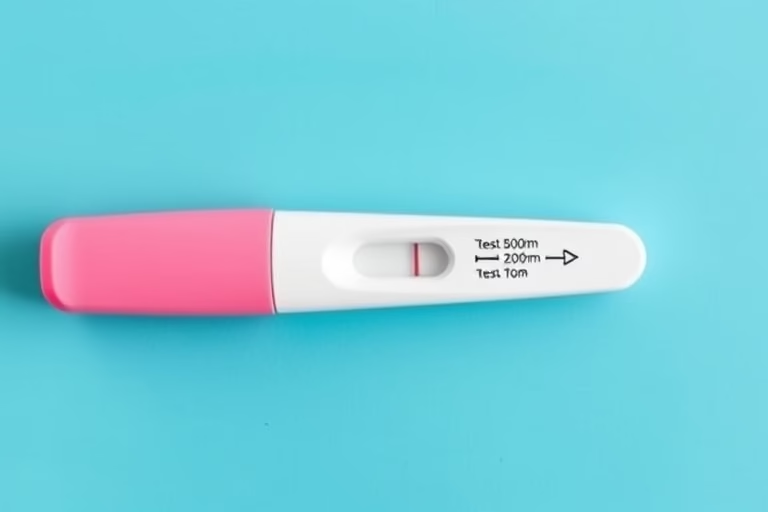Understanding Implantation Bleeding
When we discuss implantation bleeding, it refers to light spotting or bleeding that can occur when a fertilized egg implants itself into the lining of the uterus. This event typically takes place about 6 to 12 days after conception. Many women look for signs of implantation bleeding to gauge whether they may be pregnant.
This bleeding can vary in color from light pink to brown and often lasts for only a short period, usually a few hours to a couple of days. It is important to distinguish implantation bleeding from a regular menstrual period, as the two can sometimes be confused. Understanding the timing and characteristics of implantation bleeding can assist women in determining when to take a pregnancy test.
What is Pregnancy Test?
To understand when to take a pregnancy test, it is essential to know how these tests function. A pregnancy test detects the presence of the hormone human chorionic gonadotropin (hCG) in a woman’s urine or blood. This hormone is produced after a fertilized egg implants in the uterus.
The sensitivity of the test will determine how early a result can be detected. Most home pregnancy tests can provide accurate results approximately one week after a missed period. However, for those experiencing implantation bleeding, it may be beneficial to wait a few days after the bleeding has stopped for the best results. Higher levels of hCG make it clearer whether a woman is pregnant or not.
Understanding the timing of your cycle in relation to your implantation bleeding is vital for determining the most appropriate moment to take a pregnancy test. Timing can significantly affect the accuracy of the test results.
Timing is Crucial
When it comes to pregnancy tests, timing can make all the difference. Taking the test too early may lead to false negatives. Since levels of hCG take time to build up after implantation, testing within a few days of experiencing implantation bleeding improves the chances of an accurate result.
The ideal time for testing is typically about a week after you notice any bleeding. At this stage, the hormone levels will be high enough in most women for pregnancy tests to detect, leading to more reliable results.
It is important to keep track of your menstrual cycle, ovulation days, and any signs of possible implantation bleeding to better plan when to take a pregnancy test.
Characteristics of Implantation Bleeding
Identifying the characteristics of implantation bleeding can help differentiate it from a menstrual period. Typically, implantation bleeding is:
Recognizing these features can help pregnant women understand whether the bleeding is a sign of implantation, thus indicating the right time to conduct a pregnancy test. Tracking these signs can lead to an earlier and more accurate determination of pregnancy.
Types of Pregnancy Tests Available
There are primarily two types of pregnancy tests used to determine pregnancy: urine tests and blood tests. Each has its own set of advantages and might be suitable depending on individual situations.
Urine tests are the most common and are available for home use. These tests are generally affordable, quick, and easy to use. For the best results, it’s recommended to use first-morning urine since it contains the highest concentration of hCG.
Blood tests are conducted in a healthcare setting and can detect pregnancy earlier than urine tests. There are two types of blood tests:
Depending on your situation, you can choose either type of test, keeping in mind when to take a pregnancy test in relation to possible implantation bleeding for the best results.
False Negatives and False Positives
It is crucial to understand the possibility of false negatives and false positives when using a pregnancy test. A false negative occurs when a test indicates that you are not pregnant when, in fact, you are. This often happens if the test is taken too early or if it is not used correctly.
Similarly, false positives can occur, although they are rare. A false positive indicates pregnancy when you are not pregnant. This can happen due to various factors, including taking medications that contain hCG or having a medical condition that affects hormone levels.
To minimize these risks, always follow the instructions carefully. Consider waiting a few days after experiencing implantation bleeding before taking a home pregnancy test to ensure the most accurate results.
Common Misconceptions
Many misconceptions exist surrounding pregnancy tests and implantation bleeding. A prevalent belief is that a blood test is always more reliable than a urine test, which is not entirely accurate. Both tests are effective; however, the timing and individual health factors should dictate which test is best.
Another misconception is that all bleeding during early pregnancy is implantation bleeding. This is not the case, as other factors, like miscarriage or hormonal changes, can cause similar bleeding.
Finally, some people think that a positive result should be instantaneous, while others believe that all pregnancy tests are the same. Each test has different sensitivity levels and timelines for displaying results, so understanding the specific product is essential.
Factors Influencing Test Results
A variety of factors can influence the accuracy of a pregnancy test. These include the sensitivity of the test, how closely you follow the instructions, the timing of when you take the test in relation to implantation bleeding, and individual physiological factors such as hormone levels and dilution of urine.
Always check the expiration date and read the instructions carefully for the specific brand being used. If unsure about the results, it’s wise to consult with a healthcare professional for further guidance.
Final Thoughts
In conclusion, understanding when to take a pregnancy test after noticing signs of implantation bleeding is crucial for accurate results. Recognizing what implantation bleeding is, distinguishing it from a menstrual period, and knowing the characteristics can help women assess their pregnancy status effectively. Timing, the type of tests available, and being aware of false negatives and positives can also significantly influence the interpretation of results.
Every woman’s body is unique and may react differently during this process. Keeping a record of menstrual cycles, ovulation days, and symptoms will help in accurately determining the timing for taking a pregnancy test. If you suspect you might be pregnant, take the necessary steps to confirm it while keeping in mind that patience can lead to better results.
Frequently Asked Questions
- What color is implantation bleeding? Implantation bleeding can appear as light pink or brown and is usually much lighter than menstrual blood.
- How long does implantation bleeding last? Implantation bleeding typically lasts from a few hours to a couple of days.
- Can I take a pregnancy test during implantation bleeding? It is advisable to wait a few days after the bleeding has stopped for the most accurate test results.
- What if I get a negative test after implantation bleeding? If you receive a negative result but still suspect pregnancy, wait a few days and test again or consult with a healthcare professional.
- When should I consult a doctor? Consult a healthcare professional if you experience heavy bleeding or cramping, as these may indicate complications.
Further Reading
What Type of Psychotherapy Is Best for Anxiety?







